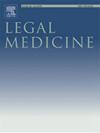评价NF-κB和SIRT1对死前和死后伤口的区别。法医实践中皮肤伤口生命力的潜在标志
IF 1.3
4区 医学
Q3 MEDICINE, LEGAL
引用次数: 0
摘要
背景:许多关于伤口年龄估计的研究已经进行了,但迄今为止还没有任何标记物被证实可以在常规法医实践中使用。为了探索伤口活力的新标志物,我们研究了炎症相关标志物核因子κB (NF-κB)的表达,并分析了其与沉默信息调节因子sirtuin 1 (SIRT1)蛋白的相关性。方法:对8例被截肢的人体肢体,取截肢部位的皮肤组织标本作为死前标本,取保存的相应肢体创面的皮肤组织标本作为死后标本。对样品进行western blot和免疫组织化学分析,以评估NF-κB和SIRT1蛋白的表达。结果:死前创面表皮细胞中NF-κB的细胞质和细胞核染色高于死后创面,且NF-κB信号主要定位于角质形成细胞的细胞核内。定量分析显示,死前伤口中NF-κB蛋白含量增加2倍。相反,死前创面中几乎不存在SIRT-1水平,而死后创面中角质形成细胞中检测到高核染色。定量分析显示,死后伤口中SIRT1蛋白增加了3倍。结论:NF-κB和SIRT1在死前和死后的伤口中表现出不同的定性和定量表达模式。它们代表了法医病理学伤口活力评估的良好候选生物标志物,最终将它们纳入生物标志物面板。本文章由计算机程序翻译,如有差异,请以英文原文为准。
NF-κB and SIRT1 evaluation to discriminate antemortem from postmortem wounds. Potential markers of skin wound vitality in forensic practice
Background many studies have been conducted on wound age estimation, but to date no marker has been validated to use in routine forensic practice. To explore novel markers for vitality of wounds, we investigated the expression of the inflammatory-related marker nuclear factor kappa B (NF-κB) and analyzed its correlation with the silent information regulator sirtuin 1 (SIRT1) protein in skin wounds. Methods: on 8 amputated human limbs we collected human skin tissue samples from the amputation site, as antemortem samples, and from wounds produced on the stored corresponding limbs, as postmortem samples. Samples were processed for western blot and immunohistochemistry analysis to evaluate the ex-pression of NF-κB and SIRT1 proteins. Results: cytoplasmic and nuclear staining of NF-κB in epidermal cells of antemortem wounds was higher than in postmortem wounds, where the NF-κB signal was mainly localized in the nuclei of keratinocytes. Quantitative analysis demonstrated a 2-fold increase in NF-κB protein in antemortem wounds. On the contrary, SIRT-1 levels were almost absent in antemortem wounds, while high nuclear staining was detected in keratinocytes in postmortem wounds. Quantitative analysis of the stained area demonstrated a 3-fold increase in SIRT1 protein in postmortem wounds. Conclusions: analysis of NF-κB and SIRT1 showed a different qualitative and quantitative pattern of expression in antemortem and postmortem wounds. They represent good candidates as biomarkers in wound vitality estimation in forensic pathology eventually to include them in a panel of biomarkers.
求助全文
通过发布文献求助,成功后即可免费获取论文全文。
去求助
来源期刊

Legal Medicine
Nursing-Issues, Ethics and Legal Aspects
CiteScore
2.80
自引率
6.70%
发文量
119
审稿时长
7.9 weeks
期刊介绍:
Legal Medicine provides an international forum for the publication of original articles, reviews and correspondence on subjects that cover practical and theoretical areas of interest relating to the wide range of legal medicine.
Subjects covered include forensic pathology, toxicology, odontology, anthropology, criminalistics, immunochemistry, hemogenetics and forensic aspects of biological science with emphasis on DNA analysis and molecular biology. Submissions dealing with medicolegal problems such as malpractice, insurance, child abuse or ethics in medical practice are also acceptable.
 求助内容:
求助内容: 应助结果提醒方式:
应助结果提醒方式:


